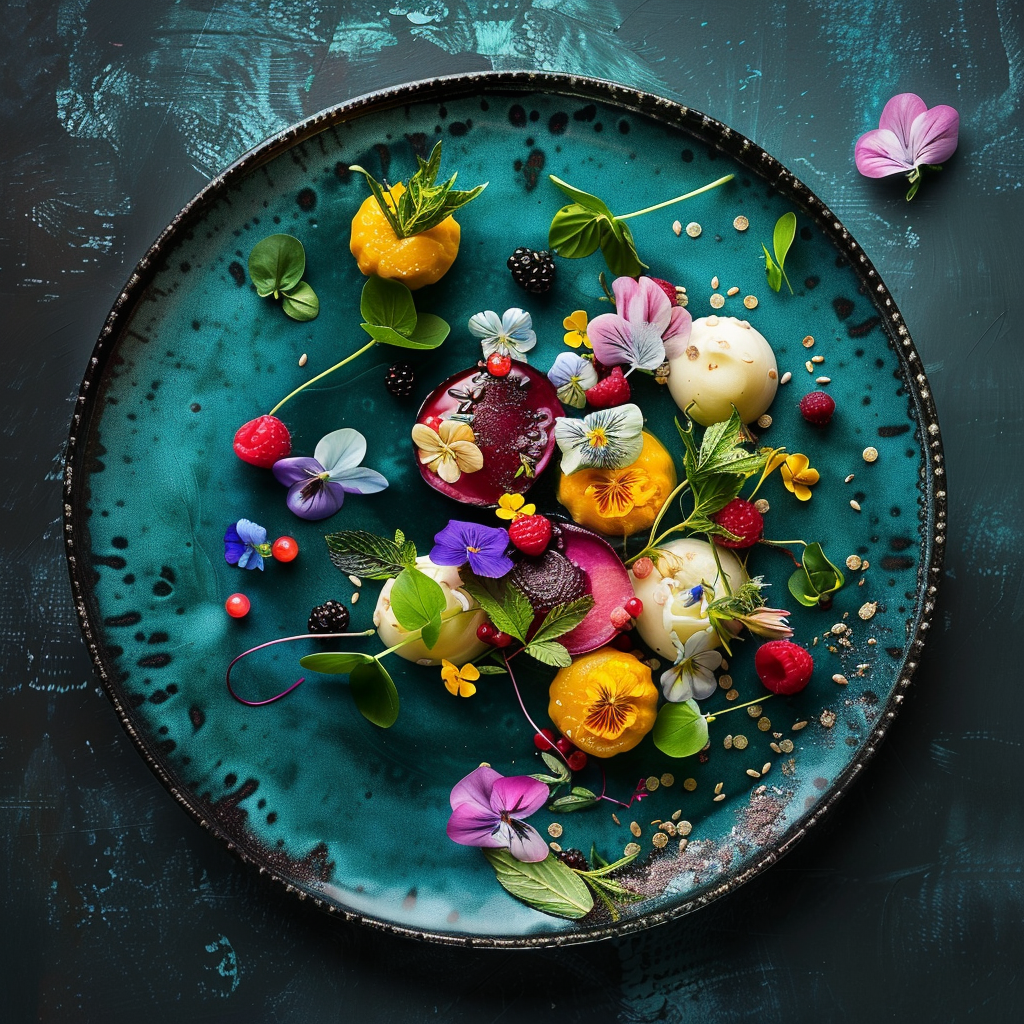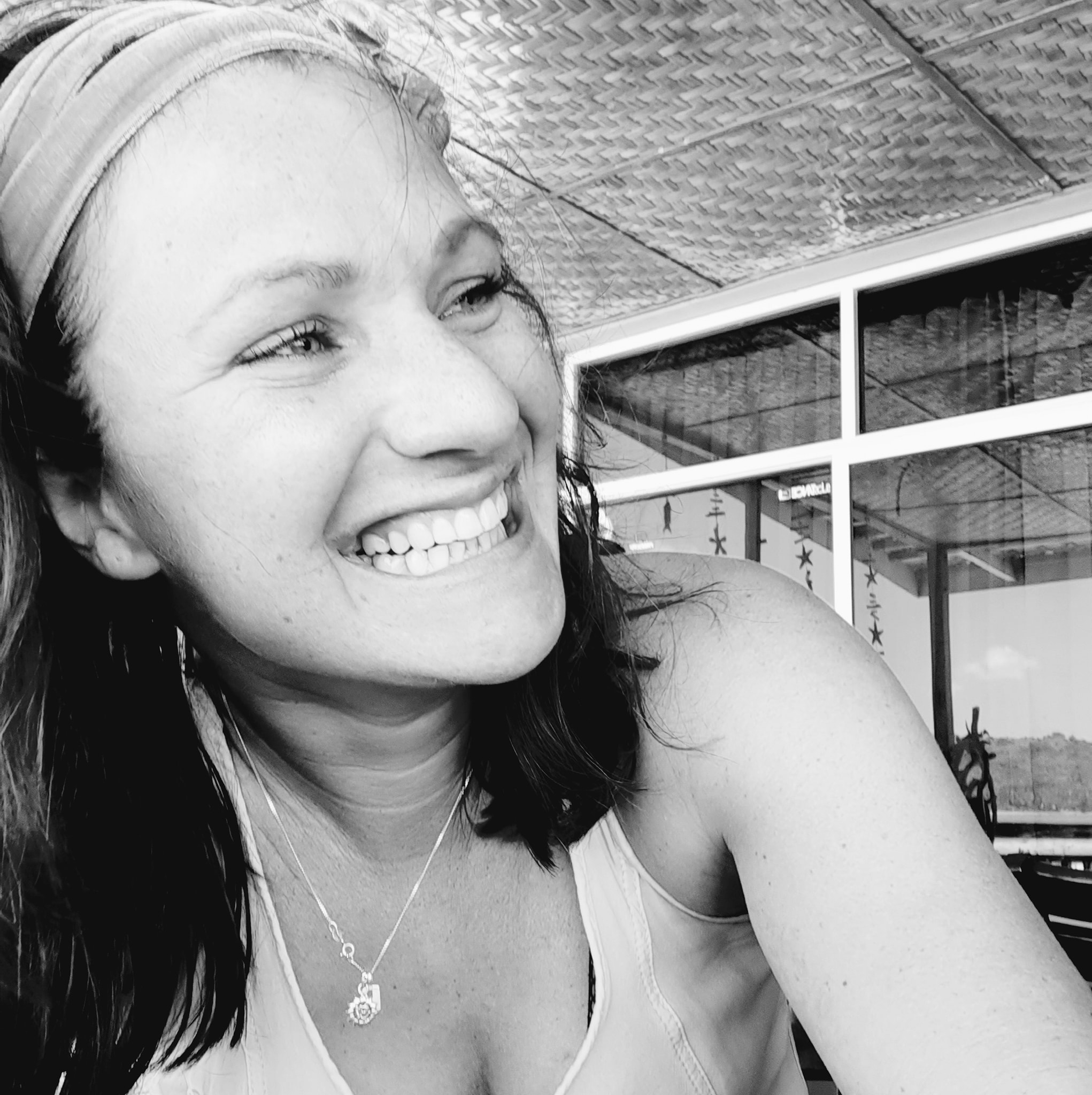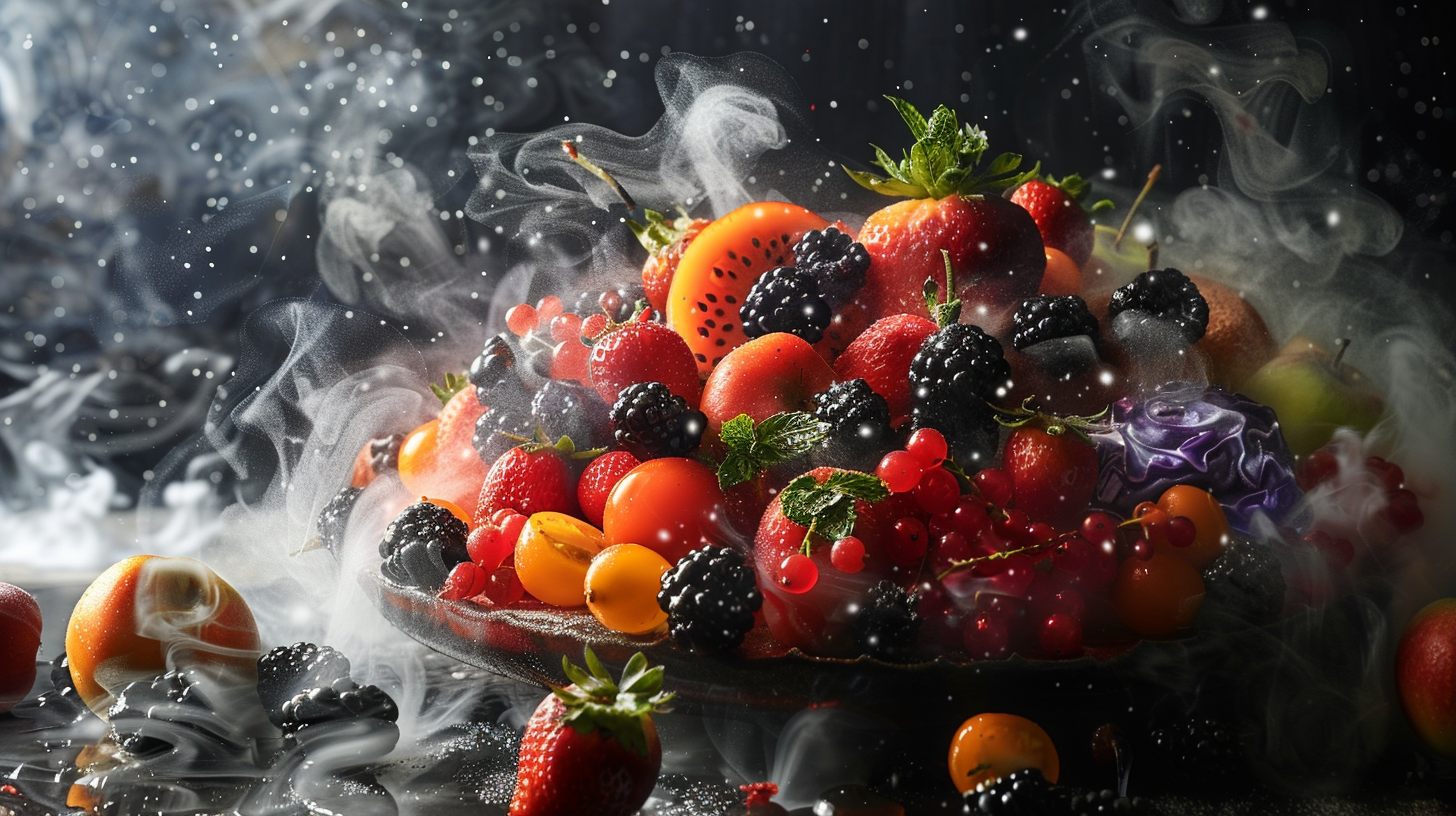Contents
- Key points
- What is Artistic Food Photography?
- The Role of Creativity in Food Photography
- How Food Photography Styles Have Changed
- Effective Tips for Food Photography Composition
- Natural Light vs. Artificial Light
- Playing with Light and Dark
- Color Temperature and Mood
- Color Palettes and Textures
- The Impact of Food Arrangement
- Basic Editing Techniques
- Advanced Editing for Artistic Flair
- Filters and Effects to Convey Style
- Conceptualizing the Narrative
- Capturing Emotion and Atmosphere
- Consistency in Visual Storytelling
- Studying the Work of Renowned Food Photographers
- Incorporating Non-Traditional Elements
- Pushing Boundaries and Trying New Techniques
- Frequently Asked Questions (FAQ)
Key points
• Arranging and Styling: Taking pictures of food is more than just snapping a photo of a meal. It’s about arranging everything neatly and choosing the right style to make the picture look good. This means putting food in just the right place, picking out props, and thinking about colors and textures to make everything look nice and balanced.
• Using Light: Getting the lighting right is really important in making food look great in photos. Sunlight is usually the best because it makes the food’s colors and textures look their best, but sometimes artificial light is used to put the spotlight on parts of the dish or create a certain mood.
• Different Views: Trying out new angles and ways of looking at the food can make your pictures really stand out. Zooming in can show off little details and textures, while taking pictures from above can give a neat, simple look. Messing around with what’s in focus, like making the background blurry, can give food photos an artistic edge.
What is Artistic Food Photography?

Artistic food photography is more than just snapping pictures of meals. It’s about making a photo that really shows off the spirit of the food and dishes in an eye-catching way. In this kind of photography, it’s not enough to simply show what’s on the plate. Photographers are out to build an experience with their cameras. They use tricks to bring out shapes, stir up emotions, and make photos that aren’t just memorable—they’re like pieces of art all by themselves.
The Role of Creativity in Food Photography

Being creative is key if you’re into snapping pictures of food that are more art than just a simple pic. It gets photographers to try out new angles, play with light and dark, splash in some color, and toss in various items for effect. The artistic decisions shape what the photo feels like and the story it tells. Sure, knowing your way around a camera helps to nail those top-notch photos, but it’s really the unique flair that sets one snapshot apart from the rest and stamps it with the photographer’s personal touch.
How Food Photography Styles Have Changed

Gone are the days of simple snapshots just to sell food. Now, our pictures paint a picture, and they’ve sure changed a lot. Thanks to Instagram and other apps, plus some nifty tech upgrades, photographers have way cooler gear. What’s hot right now? Keeping it simple, letting the sunlight in, and making sure everything looks pretty real. It’s all about catching the vibe of how we’re all about food today.
“`html
Effective Tips for Food Photography Composition

When you take photos, using the Rule of Thirds is a smart move. Imagine that your photo is split into nine equal parts by two lines going across and two going down. Try to place the important parts of your picture at the points where these lines meet. This method makes your photos look good and balanced, drawing the viewer’s eye right to the interesting spots.
Making Use of Empty Spaces
In food photography, the empty space around your main subject—heaps important. Instead of filling up every inch of the picture, leave some areas blank. This doesn’t distract from your main focus but rather highlights it, often giving off a clean, classy vibe. Use this empty space to make your subject stand out, which can make your photo seem simple yet fancy.
Adding Symmetry and Patterns
Putting in some symmetry or repeating designs can really make a normal photo pop. Our minds love it when things are neat and repeat themselves, so adding these features is usually a hit with people looking at your photos. You might find symmetry already in how a table is set or you can arrange plates and utensils yourself to get it. And don’t forget about patterns—either in the food or in the background—that can spice up your shots and bring everything together nicely.
Trying Out Different Angles
The view you choose to take your photo from can really change what your food looks like. Try different angles to see which one makes your dish look the best. Maybe shooting from above to get everything in, or from the side like you’re sitting at the table. Changing up the angle can be a strong way to show off each meal in its own way. Think about how light hits the food from different angles; it can make textures and details stand out.
To master composition is more than just plonking stuff down in front of a camera. It’s crafting an image that tells a tale without words, something that stops someone in their tracks, and if you’re doing it right, gets their tummy rumbling. Remember these tips while you work on your food photography skills and you’ll see some real improvement.
Natural Light vs. Artificial Light
It’s important to pick the correct lighting for food photography. Sunlight gives your photos a gentle, natural feel which makes them look real. Morning or late afternoon is prime time because the light isn’t too harsh. Meanwhile, fake light lets you do what you want with it. You get the same outcome no matter when you shoot. Use either depending on the vibe you want and how easy it is to set up in your location.
Playing with Light and Dark

Tinkering with light and dark areas can give your food photos more depth. Think about where light hits and the shadows it makes to bring out texture and form. For lively shots, balance is important: you want bright spots to highlight the main parts but not so much it blurs the finer points. Shadows should be there too, but not so dark they take over. Getting this mix right can make your food look almost three-dimensional.
Color Temperature and Mood

The color temperature is key when creating the right atmosphere. Warm colors can give a snug, appealing vibe, which is great for home food or treats from a bakery. On the other hand, cool colors suggest a sense of freshness or cleanliness, making them a go-to choice for drinks and seafood. You can adjust the white balance to get the feel you want, affecting how tempting and tasty your food looks.
The lighting choices you think of have a big effect on your food photographs. Working with natural light or setting up scenes with artificial lights means knowing how it changes things. Light can show off a dish’s best parts and add mood with color temperature. Keep practicing to get better at using light to make your photos pop.
Taking pictures of food isn’t just about the right light—you have to style it well too. The way you present it can make or break your photo. Start by looking at what makes the dish special, and figure out the best way to show those features. It could be the steam rising from a hot steak or the bright colors in fresh fruit—focus on these details for an eye-catching shot.
Selecting Props and Backgrounds
Choosing good props and backgrounds really sets the stage for your food photography. Look for things that add to the dish but aren’t too distracting. This could range from old-fashioned silverware to simple wooden planks.
Also, think about how the textures and shades of your props go with the theme of your dish. For instance, a bright ceramic dish may be awesome for a tangy salad with citrus fruits.
Color Palettes and Textures

Add color and texture to food photos to make them stand out. When you pair different colors, they can either match the food or be completely different to catch someone’s eye. The same goes for textures. Mix them up to give your pic some depth – that way, it’ll really pull people in.
The Impact of Food Arrangement

The way you arrange food on a plate can make a big difference to a photo’s appeal. Instead of piling it all up haphazardly, taking time to place foods deliberately makes it look more tempting. Use the main ingredients as focal points and add garnishes carefully to catch the eye, not clutter the scene. You want to make the dish look irresistible, afterall.
Editng the photos afterwards is just as important. This step means fine-tuning your pictures with software to get them looking just right. At this point, photographers adjust many features in their images to improve colors, fix any flaws, and set a mood that fits the food they’ve captured.
Basic Editing Techniques
The first round of editing often involves fixing lighting and color balance which prepares the photo for further artistic touches. Adjusting brightness helps show off details in both light and dark areas, adding depth. Sharpening also plays a role but should be used lightly to avoid making the food look fake. These initial tweaks set the stage for more complex edits down the line.
Advanced Editing for Artistic Flair
With the groundwork laid, advanced editing lets you really put your stamp on the photo. Here, editors may alter hues and saturation to reflect the food accurately or just for artistic impact. They might also highlight certain parts of the image through techniques like dodging and burning, directing the viewer’s attention to where they want it.
Filters and Effects to Convey Style
Adding filters and effects can really define a photographer’s style. Using them wisely, subtle vignettes can create an old-time feel or keep eyes on the center of the frame, and adding grain might give digital shots a classic film vibe. On the flip side, clarity and detail filters can bring out textures so every ingredient has its moment in the spotlight. Each effect chosen should help tell the story that the photographer wants to share.
To wrap it up, post-processing is key to nailing food photography. It starts with basic adjustments for lighting and colors, goes into deeper edits, and gets finished with carefully chosen filters. The end goal is to produce photos that connect with people both visually and emotionally.
Conceptualizing the Narrative
Telling a story through a picture is crucial in food photography. It’s not just about snapping a dish but exploring what’s behind it – where does it come from, why are the ingredients special, or does it remind you of something personal? Your visuals should echo these stories. Select props and backgrounds that underscore the food’s roots or use colors that match the feelings tied to a particular meal—think warm tones for cozy soup or crisp greens for a fresh salad.
Capturing Emotion and Atmosphere
Photography needs to grab more than images; it should capture feelings and atmosphere too. The vibe in a photo can range from a lazy brunch feel to the excitement of a summer cookout. Photography tells stories without words, and lighting is central to setting the tone. Dawn’s gentle light might suggest peace, while bright midday sun can signal fun times ahead.
Consistency in Visual Storytelling
To keep your storytelling solid, make sure everything matches up. Like chapters in a novel, each photo should have a consistent style across lighting, color schemes, or textiles used. An inconsistent story loses people; strive for unity among visual elements to keep your viewers hooked and enjoying each shot.
If you’re diving into the world of artistic food photography, stay open to new ideas and let your imagination run wild. Look for inspiration everywhere—from pros to new twists on classic shots. Push yourself to try unusual things; it’s how you find unique styles and methods that lift your work above the ordinary.
Studying the Work of Renowned Food Photographers
Take a good look at famous food photographers’ galleries to pick up tricks on framing, lighting, and style. Notice how they balance shadows and light or play with focus depth—it could spark fresh ideas for your own pictures and challenge you to try new angles.
Incorporating Non-Traditional Elements
Why not bring in things not usually seen in food photos? Whether it’s different textures or props that throw in a surprise element, it’s about more than just good looks—it’s conjuring up feelings or telling tales with these additions.
Pushing Boundaries and Trying New Techniques
Don’t be afraid to stretch the limits of your photography. Experiment with diverse lenses or tinker with various editing styles to stand out from the crowd. From close-ups showing off details to lively action shots that capture cooking moments, each new approach offers opportunities to grow and innovate in your craft.
Frequently Asked Questions (FAQ)
How can incorporating a dog food theme enhance my food photography portfolio?
Adding a dog food theme to your portfolio can showcase your versatility as a photographer and your ability to capture the essence of varied subject matter. Working with a food stylist specifically experienced in styling pet foods, you can create appealing images that convey texture and nutritional value. This demonstrates an eye for diversity and a capacity to attract a broader range of commercial clients.
What strategies should I adopt for a successful lunch-break themed artistic food shoot?
For a successful lunch-break themed shoot, timing is key. Utilize natural light where possible to highlight freshness. A food stylist plays a crucial role here; they need to ensure that the dishes look enticing and stay fresh throughout the shoot. A narrative or storyline that echoes the hustle of a lunch break can add emotional context to the images. Lastly, adopting unconventional angles and lighting can imbue ordinary scenes with extraordinary visual interest.
What elements are essential in styling for Holiday Cookie Exchanges and festive recipes like 'Consuetudini d'Autunno: Brownies Castagne e Cioccolato'?
The key elements in styling for Holiday Cookie Exchanges or particular festive recipes are striking color contrasts, seasonal props, and a sense of warmth. Incorporating holiday-specific ornaments and decorations adds relevance, while using premium ingredients visible in the final image suggests quality. The arrangement should be hospitable and generous in appearance to evoke the spirit of sharing associated with the holidays.
What role do platforms like iStock play in the dissemination of artistic food photography?
Platforms such as iStock significantly impact the circulation and monetization of artistic food photography. They provide exposure to a wide audience, facilitate licensing and royalty management, and offer photographers, agencies, and clients easy access to high-quality images, videos, audio, templates, and bundles. Assembled collections from various photographers create a hub for creative inspiration, ideas, and professional resources.
How can 3D technology complement traditional food photography?
3D technology introduces a new dimension to traditional food photography by enabling the creation of hyper-realistic images that can be manipulated from any angle without the constraints of a physical photoshoot. This technology is especially advantageous when exact replication of dishes is required or when specific styling elements like lighting or shadows are challenging to achieve in real life. It expands creative possibilities, allowing for more conceptualized storytelling.
Can chocolate be effectively showcased in food photography under various themes like 'Dark Christmas' or 'VEGAN PUMPKIN CINNAMON ROLLS'?
Chocolate’s versatile nature allows it easily to adapt to various themes in food photography. For a ‘Dark Christmas’ theme, chocolate works well with dark tones and richer textures to communicate indulgence and mystery. In contrast, accompanying vegan pumpkin cinnamon rolls with chocolate can introduce a luxuriously decadent element to an otherwise health-focused dish. The key to success lies in the balance – ensuring that the chocolate complements rather than overshadows the main subject.
In creating images of frosted cakes like blueberry cheesecake, how important is the correct camera settings like ISO?
Correct camera settings are vital when photographing intricate frosted cakes such as blueberry cheesecake. ISO needs to be adjusted carefully to minimize noise yet ensure adequate light sensitivity. Alongside this, depth of field managed through aperture settings is crucial in capturing both the smooth frosting surface and detailed embellishments like fruit toppings or dustings of sugar, contributing to the overall allure of the photograph.
What considerations should be taken when photographing complex burgers such as ones with pecans and brown mushroom patties?
When photographing multifaceted burgers with unique additions like pecans and brown mushroom patties, maintaining textural integrity becomes paramount. Techniques include selecting a suitable backdrop to complement the rustic nature of mushrooms and using side-lighting to accentuate pecan crunchiness. Detailed shots are instrumental in capturing the layers and complexity, invoking desire in potential customers. Additionally, working with a proficient food stylist helps maintain the burger’s structural integrity during the shoot.

About Author
Rachel Noël is a professional photographer and videographer from the UK with over 10+ years of experience. Rachel specializes in Underwater, Tavel & Portrait photography among other areas.
